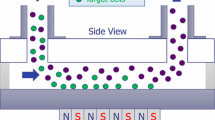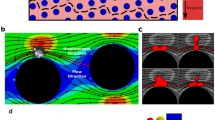Abstract
The separation of cells from a complex sample by immunomagnetic capture has recently obtained increased attention for microfluidic applications. Here, we present a simulation approach for immunomagnetic separation in a flow-through microfluidic environment that for the first time takes binding kinetics of beads to target cells as well as binding of multiple beads per cell into account. The approach is implemented into a computational fluid dynamics code and facilitates the tailored design of microfluidic magnetophoretic devices with an optimised separation performance. Although the specific computational model under study is constrained to a 2D geometry, appropriate parameter sets that allow for a continuous separation of cell/bead complexes from non-magnetic particles could be derived. In addition, based on magnetophoretic mobilities, a critical threshold value of beads per cell is revealed, where further binding is considerably reduced or the reaction cascade ceases.








Similar content being viewed by others
References
Cullity BD (1972) Introduction to magnetic materials. Addison-Wesley, Reading
Deponte S, Steingroewer J, Löser C, Boschke E, Bley T (2004) Biomagnetic separation of Escherichia coli by use of anion-exchange beads: measurement and modeling of the kinetics of cell–bead interactions. Anal Bioanal Chem 379(3):419–426
Elimelech M, Jia X, Gregory J, Williams RA (1998) Particle deposition and aggregation: measurement, modelling and simulation. Butterworth-Heinemann, London
Gijs MAM (2004) Magnetic bead handling on-chip: new opportunities for analytical applications. Microfluid Nanofluidics 1:22–40
Gomez SM, Choy G, Kabir N, Leonard EF (1999) Capture of rare cells in suspension with antibody-coated polystyrene beads. Biotechnol Prog 15(2):238–244
Jackson JD (1998) Classical electrodynamics. Wiley, New York
Kim KS, Park J-K (2005) Magnetic force-based multiplexed immunoassay using superparamagnetic nanoparticles in microfluidic channel. Lab Chip 5:657–664
Kim J, Steinfeld U, Lee HH, Seidel H (2007) Development of a novel micro immune-magnetophoresis cell sorter. In: Proceedings of the 6th Annual IEEE Conference on SENSORS, Atlanta, pp 1081–1084
McCloskey K, Chalmers JJ, Zborowski M (2003) Magnetic cell separation: characterization of magnetopohoretic mobility. Anal Chem 75(4):6868–6874
Mikkelsen C, Bruus H (2005) Microfluidic capturing-dynamics of paramagnetic bead suspensions. Lab Chip 5:1293–1297
Mikkelsen C, Hansen MF, Bruus H (2005) Theoretical comparison of magnetic and hydrodynamic interactions between magnetically tagged particles in microfluidic systems. J Magn Magn Mater 293:578–583
Pamme N (2006) Magnetism and microfluidics. Lab Chip 6:24–38
Pamme N, Wilhelm C (2006) Continuous sorting of magnetic cells via on-chip free-flow magnetophoresis. Lab Chip 6:974–980
Pankhurst QA, Connolly J, Jones SK, Dobson J (2003) Applications of magnetic nanoparticles in biomedicine. J Phys D Appl Phys 36(13):R167–R181
Rosenzweig RE (1997) Ferrohydrodynamics. Dover Publications, New York
Shevkoplyas SS, Siegel AC, Westervelt RM, Prentiss MG, Whitesides GM (2007) The force acting on a superparamagnetic bead due to an applied magnetic field. Lab Chip 7:1294–1302
Warnke KC (2003) Finite-element modeling of the separation of magnetic microparticles in fluid. IEEE Trans Magn 39(3):1771–1777
Acknowledgments
The work has been supported by the DFG-Forschergruppe FOR 516/1. Swati Mohanty, acknowledges the Alexander von Humboldt Stiftung, Bonn, for granting her a research fellowship. Part of this work was presented at the “Sixth international ASME conference on nanochannels, microchannels and minichannels”, ICNMM 2008, held in Darmstadt, Germany. We kindly thank ASME for allowing us to reuse the material. The authors would like to thank Gunther Brunklaus for critical reading of the manuscript.
Author information
Authors and Affiliations
Corresponding author
Rights and permissions
About this article
Cite this article
Baier, T., Mohanty, S., Drese, K.S. et al. Modelling immunomagnetic cell capture in CFD. Microfluid Nanofluid 7, 205–216 (2009). https://doi.org/10.1007/s10404-008-0376-3
Received:
Accepted:
Published:
Issue Date:
DOI: https://doi.org/10.1007/s10404-008-0376-3




